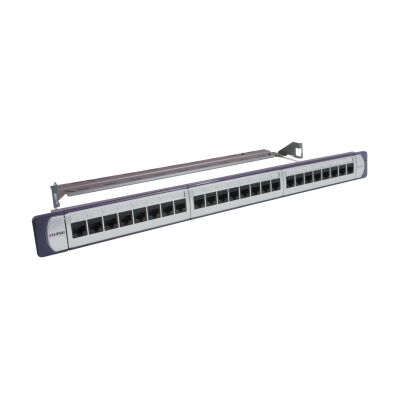Kingsgrove Branch:
Patch Panel

In today's connected world, whether you're running a busy office in Melbourne or setting up a robust home network in Perth, cables are everywhere. Computers, printers, servers, IP cameras, Wi-Fi access points – they all need to be connected. And at the heart of many organised and efficient cabling systems lies a crucial, yet often overlooked, component: the patch panel.
So, what exactly is a patch panel, and why is it such a vital piece of kit in modern data networks, right across Australia? Let's untangle its purpose.
What is an Electrical Patch Panel?
Simply put, a patch panel is a mounted hardware unit that contains a series of ports for connecting and managing network cables. Think of it as a centralised, passive connection point where all your individual network cables from different locations (like wall outlets in various rooms or devices) converge.
Instead of running long, dedicated cables directly from each device to your network switch or router, you run permanent, in-wall or in-ceiling cables from each data outlet to the patch panel. Then, shorter, flexible "patch cables" are used to connect the patch panel's ports to your active network equipment (switches, servers, etc.).
Patch panels are commonly found in server racks or communication cabinets in data centres, offices, and increasingly, in larger smart homes or commercial buildings with extensive networking needs.
Key Features and Components
A typical patch panel will feature:
- Front-Facing Ports: These are usually RJ45 (Ethernet) jacks, labelled numerically or with descriptive names, allowing for easy connection of patch cables.
- Rear Connections (Punch-Down Blocks): On the back, you'll find punch-down terminals (like 110-type or Krone blocks) where the individual wires of your permanent network cables (e.g., Cat5e, Cat6, Cat6A) are terminated.
- Rack-Mountable Design: Most patch panels are designed to fit standard 19-inch equipment racks, making them integrate seamlessly into structured cabling systems.
- Passive Device: Importantly, a patch panel is a passive device. It doesn't use electricity, process data, or perform any network functions. Its sole purpose is to provide physical connections.
Why is a Patch Panel So Important? The Benefits
The benefits of using a patch panel are significant for any serious network installation:
- Organisation and Management: This is its primary strength. A patch panel brings order to chaos, neatly terminating all network cables in one central location. This makes troubleshooting, adding new connections, or reconfiguring the network far easier.
- Flexibility and Scalability: Need to move a computer to a different network port? Just re-patch a short cable on the panel to the switch. Want to add a new device? If the cable is already run to the panel, it’s a simple patch. This flexibility is invaluable in dynamic environments.
- Protection for Equipment: By using short patch cables, you reduce wear and tear on the more expensive ports of your active network switches. If a patch cable or a panel port gets damaged, it's cheap and easy to replace, rather than having to repair or replace a switch port.
- Professionalism: A patch panel is a hallmark of a professional, structured cabling installation. It enhances the aesthetics of your communications room and simplifies future maintenance.
- Troubleshooting Made Easier: If a network connection goes down, you can quickly isolate the problem by checking the status lights on the switch and tracing the patch cable to the corresponding panel port.
Different Types of Patch Panels
While RJ45 Ethernet patch panels are the most common, you can also find:
- Fibre Optic Patch Panels: For terminating and managing fibre optic cables.
- Voice Patch Panels: For traditional telephone lines.
- Coaxial Patch Panels: For RF or video signals.
The principle remains the same: a central point for managing physical connections.
Choosing and Sourcing Patch Panels in Australia
When setting up or upgrading your network infrastructure in Australia, choosing the right patch panel is crucial for long-term reliability and performance. Consider factors like the number of ports you need, the cable category (Cat5e, Cat6, Cat6A), and whether you need shielded or unshielded panels.
For reliable network components that meet Australian standards and environmental conditions, sourcing from specialist electrical wholesaler and data suppliers is essential. A good supplier will offer a range of patch panels, from compact wall-mount options for smaller setups to high-density rack-mount panels for larger corporate networks.
A quality patch panel is an investment in the efficiency, stability, and future proofing of your network. It's the silent workhorse that ensures your data flows smoothly, keeping your operations humming along.
Recent posts

Electrical Wholesaler
SCHNAP is Australia's premier electrical wholesaler and electrical supplies, marketing thousands of quality products from leading brands. Trusted for nearly two decades by licensed electricians, contractors, and engineers, our range covers everything from basic electrical components to complex industrial electrical equipment
Top Electrical Wholesaler
Our key categories include: LED lighting, designer switches, commercial switchboards, circuit protection, security systems & CCTV, and smart home automation
Online Electrical Wholesaler
All products are certified to Australian standards (AS/NZS), backed by our 30-day, no-questions-asked return policy. Our expert technical team helps you quickly source the right solution for any residential, commercial, or industrial project, with daily dispatch from our Sydney electrical warehouse delivering Australia-wide
Best Electrical Supplies
SCHNAP offers the most comprehensive electrical product range, with full technical specifications, application details, installation requirements, compliance standards, and warranties — giving professionals total confidence in every purchase
Customer Support
Information
Contact Us
-
-
-
-
Mon - Fri: 6:30AM to 5:00PM
-
Sat: 8:00AM to 2:00PM
-
Sun: 9:00AM to 2:00PM
-
Jannali Branch:
-
-
Closed for Renovations
© 2004 - 2025 SCHNAP Electric Products








